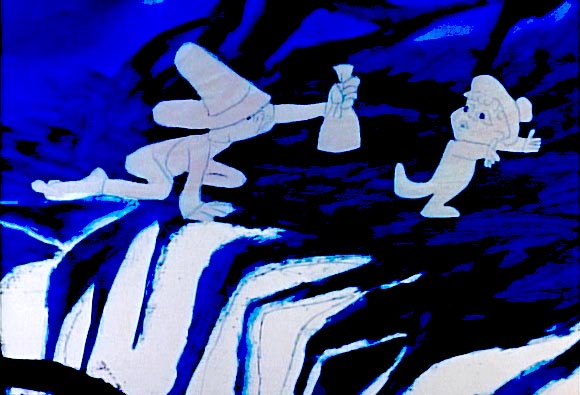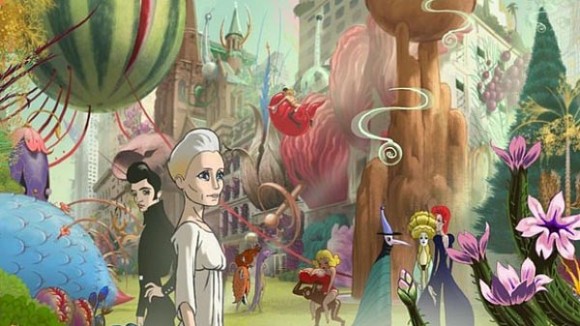The "Waltz with Bashir" director has been experimenting with a combination of 2D animation and stop-motion.
Add a CommentViewing: Blog Posts Tagged with: Waltz with Bashir, Most Recent at Top [Help]
Results 1 - 4 of 4
Blog: Cartoon Brew (Login to Add to MyJacketFlap)
JacketFlap tags: Feature Film, Anne Frank, Fantastic Mr. Fox, Ari Folman, David Polonsky, Waltz with Bashir, Yoni Goodman, The Congress, Andy Gent, Tristan Oliver, Add a tag
Blog: Cartoon Brew (Login to Add to MyJacketFlap)
JacketFlap tags: Ideas/Commentary, Nick Park, documentary, Audition, Ryan, Wonderland, Aardman Animations, Windy Day, Chris Landreth, John Hubley, Peter Lord, Creature Comforts, Faith Hubley, Waltz with Bashir, Animated Conversations, Audio production, Colin Thomas, Confessions of a Foyer Girl, David Sproxton, Down and Out, Hangovers, Jonathan Hodgson, Moonbird, Orly Yadin, Sylvie Bringas, The Trouble with Love and Sex, William Mather, Add a tag

One of the better-known shorts made by John and Faith Hubley is Moonbird, from 1959. This film came about when the Hubleys made a secret recording of their two sons one night, playing a game in which they pretended to be hunting for the elusive Moonbird. The result was a soundtrack with a complete narrative, courtesy of the two children; the Hubleys and their studio then visualised the story to create the film.
It is surprising how well Moonbird works, considering that its story is simply two kids making things up as they go along. The personalities of the children come through very strongly and much of the recorded dialogue is inherently funny, as when the younger boy tries to recite “Hey Diddle Diddle” but has trouble remembering past the second word.

Moonbird was followed by the 1967 film Windy Day, based on the same concept but using the voices of the Hubleys’ two daughters. This short is much looser, with a transformative element as the two characters morph from one identity to another. Instead of a single narrative, the children deliver a free-flowing conversation which makes several twists: The two girls start by playing at being a knight and a princess, and later play at being animals; between these sessions they discuss birth, adulthood, marriage and death in the half-grasped manner of children.
Windy Day was shown at the 1968 Cambridge Animation Festival; amongst the people who saw it were producer Colin Thomas and animator William Mather.
“We were blown away by the use of raw unpolished sound with a highly controlled medium like animation”, said Mather in an interview I conducted with him in 2011. In 1975 the two put together a pilot film entitled Audition, based around a recording of Mather’s son talking to an organ player as he auditioned for the role of a choirboy.
The film is very different to Hubley’s shorts. Aside from a very brief sequence in which the boy imagines the organ turning into a monster, it does not take place in a world of childhood fantasy: Its aim is instead to recreate the conversation in more straightforward cartoon terms.
The Hubleys sought to create fantasy films when they made Moonbird and Windy Day, and turned to the taproot of so much fantasy: the imaginations of children. By contrast, Mather and Thomas created a film which was closer to documentary. It is worth noting that Thomas was a documentary filmmaker, and that BBC Bristol – the branch for which the two men made their pilot – has a strong documentary tradition.

The pilot led to Animated Conversations, a six-part series produced in the late-1970s by various directors. Mather contributed Hangovers, based on a recording of a barmaid and her customers, but the best-known shorts for this series were made by Aardman founders Peter Lord and David Sproxton.
The two Aardman shorts take quite different approaches. Down and Out is a literalistic portrayal of an elderly man being turned away from a hostel which – unlike Mather’s shorts – lacks any humor; its emphasis is instead on pathos. Confessions of a Foyer Girl, on the other hand, plays its material for laughs. A young cinema employee discussing the banal details of her day-to-day life is contrasted with the glamorous and exciting world of the movies.
Lord and Sproxton’s work on Animated Conversations prompted Channel 4 to commission its own series of animation based on natural dialogue, this time made entirely by Aardman: Late Edition, Sales Pitch, On Probation, Early Bird
and Palmy Day. As before, some of these went for wacky comedy, while others opted for melancholy tones.
Aardman’s subsequent work in this format includes Creature Comforts by Nick Park. As well as ranking as the single most famous example of the approach, it is one of the more playful in using its soundtrack. As the film is framed as a series of short interviews with various characters, Park was able to home in on the soundbites with the most comic potential. The earlier shorts built themselves around large chunks of undigested conversation, but the whole point of Creature Comforts is that the interviewees are quoted completely out of context.
Creature Comforts became an entire franchise, and in is now the key example of what is, today, a full-fledged genre of animation.
Sometimes the approach can serve a practical use. Animation students are often assigned the task of working to found soundtracks as lipsync exercises. “The Trouble with Love and Sex,” a 2011 episode of the BBC documentary series Wonderland, focused on people undergoing counselling; when it ran into the problem that these people were not comfortable being filmed, it simply used their voices, the visuals being animated by Jonathan Hodgson.
Meanwhile, other animators returned to the daring ethos of the Hubley shorts. Chris Landreth’s Ryan plays with intertextuality, using animation to illustrate interviews with and about animator Ryan Larkin. Sylvie Bringas and Orly Yadin’s’s Silence presents a child’s eye view of the Holocaust, alternating between harsh, woodblock-like sequences for the camp scenes and a softer, more childlike style for the postwar sequences.

There are three general approaches taken by these films. The first is a literalistic portrayal of the conversation, as with the melancholy Down and Out, the lighthearted Late Edition and the harrowing Waltz with Bashir (the last of these being the only feature-length animation of this type that I am aware of.) The second approach creates comedy by placing ordinary dialogue into an unusual situation, as with Creature Comforts.
Finally, the third approach uses animation to illustrate the more subjective aspects of the soundtrack, usually by attempting to recreate the mental state of the speaker. Examples include Silence, Ryan, Marjut Rimminen’s Some Protection, Paul Vester’s Abductees and Andy Glynne’s Animated Minds.
Jan Svankmajer once remarked that “animators tend to construct a closed world for themselves, like pigeon fanciers or rabbit breeders.” When an animated film uses unscripted audio, what we see is pure fantasy, but what we hear is an actual moment in time—the closed world of animation is suddenly opened up to stark reality.
IMAGES AND VIDEO IN THIS PIECE
1.) Still from Moonbird
2.) Still from Windy Day
3.) Audition
4.) Still from Confessions of a Foyer Girl
5.) Still from Creature Comforts
6.) Clip from “The Trouble with Love and Sex”
7.) Still from Waltz with Bashir
Blog: Cartoon Brew (Login to Add to MyJacketFlap)
JacketFlap tags: Ari Folman, Waltz with Bashir, Drafthouse Films, Films We Like, The Congress, Feature Film, Add a tag
 The Congress, the experimental animation/live-action hybrid by Ari Folman (Waltz with Bashir), has nabbed itself a North American distributor. The deal is a co-acquisition between Drafthouse Films and Films We Like, with Drafthouse handling the U.S. theatrical and VOD/digital release in 2014 and Films We Like covering distribution for Canada.
The Congress, the experimental animation/live-action hybrid by Ari Folman (Waltz with Bashir), has nabbed itself a North American distributor. The deal is a co-acquisition between Drafthouse Films and Films We Like, with Drafthouse handling the U.S. theatrical and VOD/digital release in 2014 and Films We Like covering distribution for Canada.
The opening film of last month’s the Director’s Fortnight sidebar at Cannes, The Congress is a loose adaptation of Stanislaw Lem’s 1971 sci-fi novel The Futurological Congress, about an aging actress preserving her digital image for a future Hollywood. It stars Robin Wright, Jon Hamm, Paul Giamatti and Harvey Keitel.
Add a CommentBlog: Cartoon Brew (Login to Add to MyJacketFlap)
JacketFlap tags: Feature Film, Stanislaw Lem, Jon Hamm, Paul Giamatti, Cannes Film Festival, Robin Wright, Ari Folman, Aviv Aldema, David Polonsky, Directors' Fortnight, Harvey Keitel, Max Richter, Nili Feller, Waltz with Bashir, Yoni Goodman, Add a tag
A promising trailer was released today for The Congress, the new live-action/animated hybrid directed by Waltz with Bashir helmer Ari Folman. The film will premiere this Thursday at the Directors’ Fortnight sidebar of the Cannes Film Festival. No theatrical release dates have been set so far beyond France, where it will open on July 3.
The Congress is loosely adapted from Stanislaw Lem’s sci-fi novel The Futurological Congress, and follows an aging actress (Robin Wright) who agrees to sell a digital version of herself to a movie studio with the stipulation that she can never act again. The live-action portions of the film also star Harvey Keitel, Jon Hamm, and Paul Giamatti.
The film was produced as a co-production between Israel, Germany, France, Belgium, Poland and Luxembourg, but the creative heavylifting appears to have been done in Israel. Folman’s collaborators on Bashir rejoined him for this film, including animation director Yoni Goodman, production designer David Polonsky
, editor Nili Feller, composer Max Richter and sound designer Aviv Aldema. The Israeli paper Haaretz offers an in-depth article about how the film was conceived and produced.


